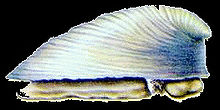- Neopilina
-
Neopilina 
Scientific classification Kingdom: Animalia Phylum: Mollusca Class: Monoplacophora Order: Tryblidiida Superfamily: Tryblidioidea Family: Neopilinidae Genus: Neopilina Species - N. bruuni Menzies, 1968
- N. galatheae Lemche, 1957
- N. rebainsi Moskalev, Starobogatov & Filatova, 1983
Neopilina is a highly derived genus of modern monoplacophoran.[1] However, molecular methods show that they fall within the polyplacophoran clade,[2] and fossil and morphological data show that they are rather derived and bear very little resemblance to an 'ancestral mollusc'.[1]
Anatomy
Its anatomy[3] led researchers to believe that the cephalopods evolved from the monoplacophora.[3]
Its pair of preoral tentacles are considered homologous to those of gastropods; like prosobranch gastropod tentacles, their nerves connect to the cerebal ganglia of the brain.[3] The post-oral tentacles are equated with bivalves' labial flaps, cephalopods' arms, and scaphopods' captacula.[3]
Cuticular hardenings around the mouth of the organism are considered to be jaw-like and very not far removed from the beaks of cephalopods, or the jaws of many gastropods.[3]
The presence of a single shell prompts comparisons to the cephalopod Nautilus, but besides its bilateral symmetry and direction of coiling, there is not a clear equivalence; Nautlius' shell is notably different in the possession of septa (and thus a sphuncle).[3]:64 It bears a similar degree of similarity to most other mollusc groups, leading to speculation that it may reflect a relatively unchanged ancestral mollusc.[3] The shell itself is aragonitic, consisting mainly of a prismatic layer,[4] lined with nacre.[3]
The organism bears five pairs of ctenidia, unusually for molluscs; the rear two are homologous to the two pairs in Nautilus. This is unlike the polyplacophora, who have a number of pairs of ctenidia, but this number varies and is not related to the number of their body 'segments'.[3]
The foot and pallial groove are very difficult indeed to discriminate from the polyplacophora,[3] supporting its placement in this group by molecular methods[2]
Its radula is not unlike that of the polyplacophora; notably, its fifth tooth is modified to be comb-like.[5]
Ecology
Neopilina is a bottom feeder, probably a deposit feeder; whilst alive, its shell is covered by a layer of mucus that might be involved in feeding or locomotion.[6]
References
- ^ a b Organisms, Genes and Evolution: Evolutionary Theory at the Crossroads ; Proceedings of the 7th International Senckenberg Conference By Dieter Stefan Peters, Michael Weingarten Contributor Dieter Stefan Peters Published by Franz Steiner Verlag, 2000 ISBN 351507659X, 9783515076593 243 pages
- ^ a b Giribet; Okusu, A; Lindgren, A.R.; Huff, S.W.; Schrödl, M; Nishiguchi, M.K. (May 2006). "Evidence for a clade composed of molluscs with serially repeated structures: monoplacophorans are related to chitons" (Free full text). Proceedings of the National Academy of Sciences of the United States of America 103 (20): 7723–7728. Bibcode 2006PNAS..103.7723G. doi:10.1073/pnas.0602578103. PMC 1472512. PMID 16675549. http://www.pnas.org/cgi/pmidlookup?view=long&pmid=16675549.
- ^ a b c d e f g h i j Lemche, H; Wingstrand, K.G. (1959). "The anatomy of Neopilina galatheae Lemche, 1957 (Mollusca, Tryblidiacea)." (Link to free full text + plates). Galathea Rep 3: 9–73. http://www.zmuc.dk/inverweb/Galathea/index.html.
- ^ Stephen Weiner and Lia Addadi (2007). "Design strategies in mineralized biological materials". http://www.rsc.org/ej/JM/1997/a604512j.pdf. - contains spectacular SEM of prismatic nature of aragonite shell.
- ^ Galathea 16. http://www.zmuc.dk/inverweb/Galathea/Pdf_filer/Volume_16/Plates_07-12-galathea-vol.16.pdf.
- ^ Menzies, R. J.; Ewing, M.; Lamar Worzel, J.; Clarke, A. H. (1959). "Ecology of the Recent Monoplacophora". Oikos 10 (2): 168–182. doi:10.2307/3565144.
Categories:
Wikimedia Foundation. 2010.
